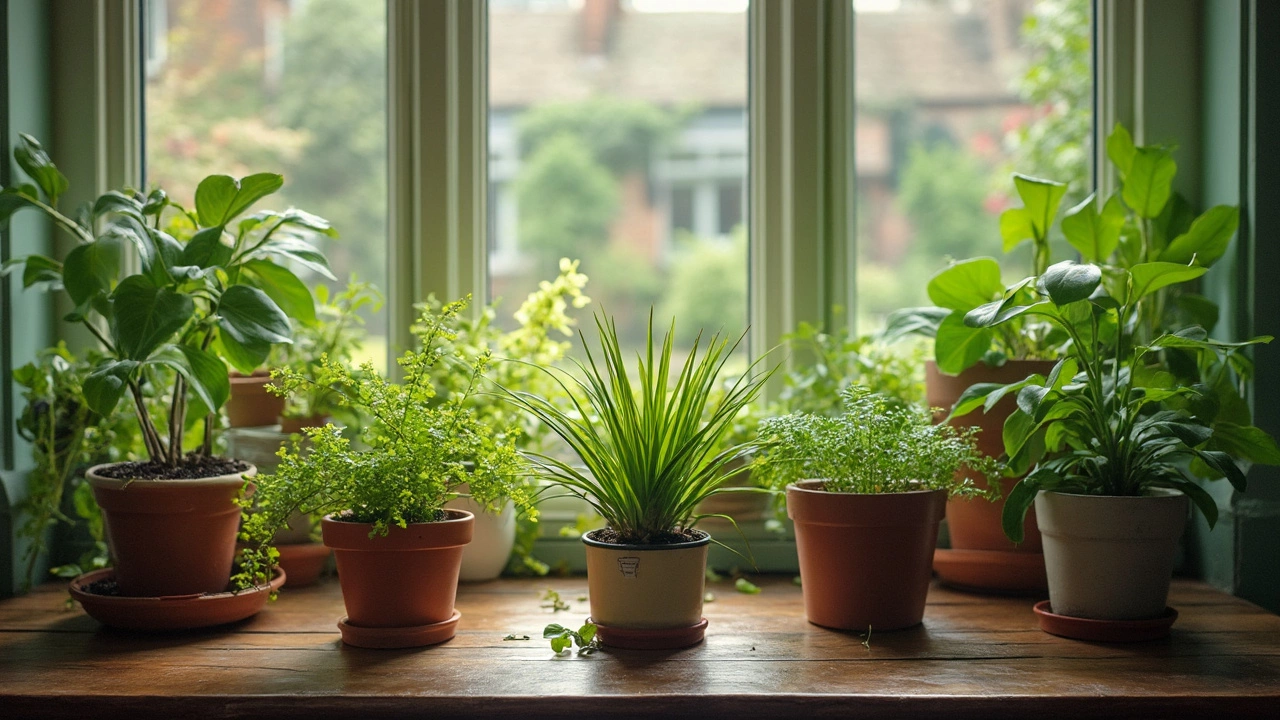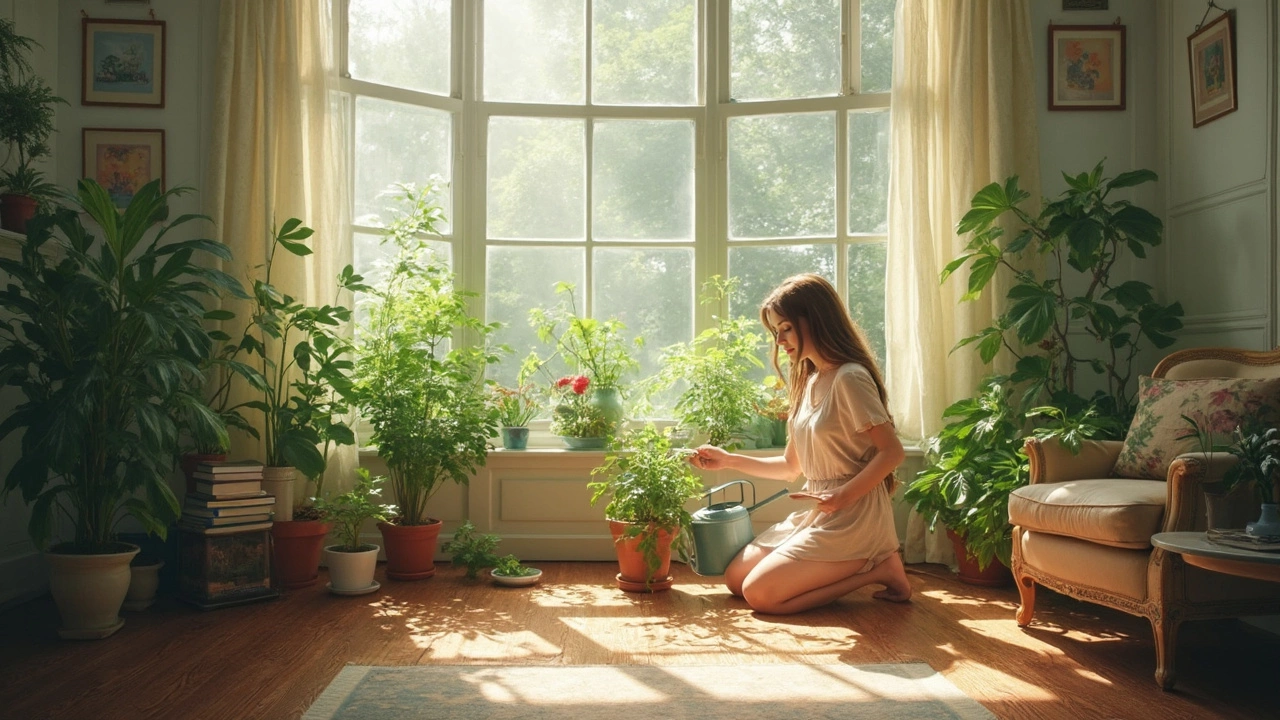You'd think taking care of indoor plants would be as simple as sticking them in a pot and remembering to water them now and then, right? But it turns out, the biggest killer of our leafy buddies isn't neglect—it's overwatering. Yep, drowning those poor plants with a bit too much H2O is a common crime committed by plant enthusiasts everywhere.
Imagine having a 24/7 buffet of water. Sounds great for a duck, but not so much for your average ficus. Plants need water, but they also need oxygen around their roots. Otherwise, they end up gasping for air under all that moisture. So, if you love your plants, learning when to hold back can save them from a soggy end.
- The Overwatering Problem
- Spotting a Thirsty Plant
- Balancing Light and Water
- Recognizing Plant Stress Signals
- Reviving a Drowning Plant
- Maintaining Plant Health
The Overwatering Problem
So, what's the deal with overwatering anyway? It’s like this: plants need water to survive, sure, but they also need air in their soil to keep things balanced. When you water too often, the soil gets waterlogged, and there's no room left for oxygen to sneak in. This can lead to root rot, where the roots literally start to decay. It sounds grim, but it’s a super common issue that can turn your leafy oasis into a mushy graveyard quicker than you’d like.
Before you overwater your green pals, check the real thirst level. Stick your finger about an inch into the soil. If it feels dry, it’s time to give it a drink; if it’s still damp, hold off. Think of it like testing a cake with a toothpick—same idea, different results.
Different plants have different hydrating needs. Cacti and succulents like it dry—think of their native desert vibes. On the other hand, tropical plants like a bit more moisture, but they still appreciate a little air at the root level. Keep in mind seasonal changes, too. Plants often need less water in winter when they’re not growing as much, and more during their active spring and summer phases.
- Check soil moisture with your finger before watering.
- Simplify your routine by watering less in winter.
- Adjust watering based on plant type: less for succulents, more for tropicals.
Being mindful of how much you’re pouring into those pots can keep your indoor jungle thriving. Just remember, it’s not about how much love you’re giving in the form of water—it’s about giving the right kind of love at the right time.
Spotting a Thirsty Plant
It's not always easy to know when your indoor plants are thirsty. You can't exactly ask them, can you? But don't worry, they do have a few little signals to let you know when they're in need of a drink. First, check the soil. If it feels dry a couple of inches down, that's often a good clue that they need some water. But there's more to it than that!
One clear sign is wilting leaves. Even the most content plant will droop a little when dehydrated. So, if your once upright and perky plant starts to look a bit like it just ran a marathon, it might be time for a drink. And those leaves? They might turn a lighter shade or even start to look crispy around the edges.
Pay attention to the soil pulling away from the edges of the pot too. If you notice a gap between the soil and the pot, your plant is thirsty. This soil shrinkage means it's desperate for moisture. So, be sure not to overlook this as your houseplant going full detective mode!
Here’s a little secret: Not all plants express thirst the same way. Some, like succulents, have thicker leaves that can store more water, meaning they might not wilt as obviously. Others, such as indoor plants like ferns, will tell you they're thirsty way sooner. Getting to know your specific plants is key.
Lastly, try using a moisture meter if you're unsure. These handy gadgets can take the guesswork out of deciding when your plant needs a drink. Insert it into the soil, and it’ll show you whether it's wet, damp, or dry. Easy peasy!
Balancing Light and Water
Indoor plants, just like us, need a good balance in life. They thrive when they get the right amount of light and water. It's not just about dumping water whenever you remember or shoving your plant by the nearest window. The trick is finding the sweet spot where light and water work together to keep your houseplants happy.
Light is crucial because it's like food for plants. Through photosynthesis, plants use light to create energy. But not all plants need the same amount of light. Some, like succulents or cacti, are sun-lovers and would enjoy being sunbathers if they could. Others, like ferns, prefer the cozy shade and can get frazzled if they catch too many rays.
Here's a simple guide to figure out where to place your indoor plants based on light needs:
- Bright Direct Light: Best for cacti and succulents. Place these near south or west-facing windows.
- Bright Indirect Light: Ideal for peace lilies or philodendrons. A few feet away from a direct sun window.
- Low Light: Suitable for ferns and snake plants. These can hang out in spots with less sun, like north-facing rooms.
Getting the water part right is just as crucial. Overwatering is a plant's nemesis, but underwatering ain't great either. The secret is to check the soil often. Stick your finger about an inch into the dirt. Is it dry? That's a sign to water. Still moist? Wait a bit longer.
Remember that how often you water can change depending on the season. In winter, when the sun’s on vacation, plants usually need less watering. Come summer, and you might need to water more frequently.
Combining the right light with the proper watering routine creates an environment where your plants can really show off. Pay attention to their leaves. Are they droopy or brown? These are SOS signals telling you to reassess their light and water relationship.
For those who love stats: a study showed that around 70% of indoor plant issues come from improper watering, mainly too much. Adjusting both water and light according to your plant's specific needs will keep them thriving, and you'll become an indoor plant care pro in no time!

Recognizing Plant Stress Signals
Ever looked at your fiddle leaf fig and wondered why it's starting to look a bit mopey? Recognizing plant stress signals early can mean the difference between a thriving jungle and a living room full of twigs. Let's break down some telltale signs that your indoor plants might be crying out for help.
First off, check out the leaves. Yellowing is a common red flag, often hinting at either too much or too little water. If the leaves are browning at the edges, your plant might be begging you to ease up on the watering can. On the flip side, crispy, dry leaves usually scream, "I need a drink!"
Another clue is the droop. Healthy plants stand tall and proud. If yours are slouching more than a teenager dragged out of bed, they might not be getting the right light or enough water. Conversely, droopy leaves can also indicate a case of waterlogging.
Then there's growth (or lack of it). Slow or no growth can suggest your plant isn't happy in its environment. It could mean wrong light levels or fluctuation in temperatures. As a quick hack, feel the soil—if it’s compacted like a breakfast pancake, roots might be suffocating.
Let’s talk about pests and diseases. If you spot white webs or tiny moving dots on the leaves, pests might be making themselves comfy. A quick rinse or a gentle wipe with soapy water usually does the trick, but chronic infestations might need something stronger.
| Problem Sign | Likely Issue |
|---|---|
| Yellowing Leaves | Overwatering/Underwatering |
| Brittle Leaves | Lack of moisture/Humidity |
| No Growth | Poor light/Compacted soil |
| Webs on Leaves | Spider mites/Pests |
So, the next time Snowball nudges you towards a wilting monstera, you'll know exactly what to look for. Armed with these tips, your indoor garden will be the envy of the neighborhood in no time!
Reviving a Drowning Plant
So, you’ve noticed your plant isn’t exactly looking perky, and you're worried it’s been overwatered. Don’t panic, there’s still hope! Overwatered plants can be saved if you act quickly.
First things first, carefully remove your plant from the pot to check out the roots. Healthy roots are usually white and firm. If you see brown and mushy roots, it's a sign of root rot. Snip off these damaged parts using clean scissors.
Now, it's time to repot. Use a fresh potting mix with good drainage – look for something that’s labeled for indoor plants. Make sure your pot has drainage holes too! This helps excess water escape instead of turning your plant's home into a swamp.
Replant your green buddy and water it lightly. Don’t drench it; just enough for the soil to settle. Place it in a spot where it gets the right light—not too intense, though, because a stressed plant can’t handle too much sun.
Finally, give your plant some time. Reviving takes a bit of patience. Watch it closely for new growth and signs of improvement over the next few weeks.
Keeping check on how much and how often you're watering is crucial. Consider keeping a schedule so you don’t fall back into the drowning habit. A moisture meter can be handy here too. With the right balance, your houseplants will be back to their thriving best.
Maintaining Plant Health
Keeping indoor plants happy isn't just about watering them right. It’s about understanding what each plant craves in terms of light, nutrients, and a bit of extra love. Let’s break down how you can make sure your green pals are thriving.
First off, light is like WiFi for plants—essential for their survival. Most houseplants love bright, indirect light. If a plant’s leaves start looking dim or pale, it might be crying out for a sunbath. Get to know the best spot in your home for each plant, and don’t be afraid to rotate them for an even light distribution.
Next, let’s talk nutrients. Just like us, plants need their greens! A balanced liquid fertilizer every few weeks during the growing season can work wonders. But don’t overdo it—too much fertilizer can burn their roots, leaving them worse off.
- Spring and summer are great times to feed your plants since they’re in growth mode.
- If you spot brown tips, it might mean you need to tone down the fertilizer.
Temperature and humidity are also key players. Most houseplants adore temperatures between 60°F to 75°F (15°C to 24°C). Watch out for drafty windows in winter or cranking the heat, as extreme temps can stress them out.
Lastly, take a moment to check if your plants are pest-free. Tiny critters like spider mites or aphids can sneak in and wreck your indoor jungle party. A quick wipe with soapy water can often do the trick in sending these uninvited guests packing.
By keeping an eye on these factors, your lovely plant collection should stay vibrant and growing. Of course, each plant species has its quirks, so a little research on specific needs never hurts. Your indoor garden will thank you!
